Finnish art
Finnish art started to form its individual characteristics in the 19th century, when romantic nationalism began to rise in the autonomous Grand Duchy of Finland.
-_Under_the_Yoke_(Burning_the_Brushwood)_-_Raatajat_rahanalaiset_-_Kaski_-_Tr%C3%A4lar_under_penningen_-_Sved_(31948645643).jpg)
Prehistoric art
Marks of human activity in Finland has found in Susiluola, Kristinestad. Some excavation has been considered as a man-made over 100,000 years ago.[1] After the Ice Age, area of Finland was resettled at around 9,000 years ago and first known sculpture Elk's Head of Huittinen (picture in stamp) has been dated about 5–7000 BCE.[1]
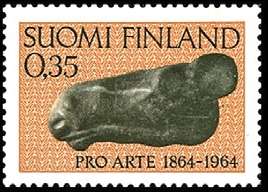 Elk's Head on a 1964 Finnish stamp
Elk's Head on a 1964 Finnish stamp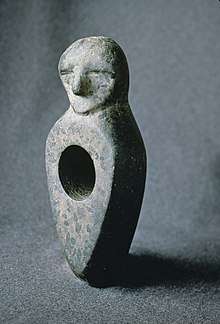 Stone age axe head with a human figure, Kiuruvesi
Stone age axe head with a human figure, Kiuruvesi Stone age bear head cudgel, Paltamo
Stone age bear head cudgel, Paltamo.jpg) Moose head figurine
Moose head figurine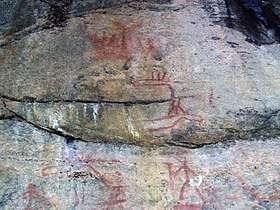 Astuvansalmi rock paintings (moose, human figures and a boat)
Astuvansalmi rock paintings (moose, human figures and a boat)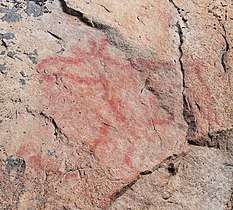 Saraakallio rock paintings (moose)
Saraakallio rock paintings (moose)
Architecture
The most important products of medieval architecture in Finland are the medieval stone churches. More than a hundred of them were built during 15th and 16th centuries. Neoclassical architecture arrived in late 18th century, but important building projects started after 1808 when Finland was an autonomic part of Russia. Alexander II of Russia commissioned Carl Ludvig Engel to plan the new Senate and University for Helsinki.[2]
 Panorama of the Helsinki Senate Square, designed by Carl Ludvig Engel. From left: the main building of University of Helsinki, Helsinki Cathedral, Government Palace. At the center is a statue of Alexander II by Walter Runeberg.
Panorama of the Helsinki Senate Square, designed by Carl Ludvig Engel. From left: the main building of University of Helsinki, Helsinki Cathedral, Government Palace. At the center is a statue of Alexander II by Walter Runeberg.
Academic visual arts


The Finnish academic drawing tradition began at Royal Academy of Turku in 1707 when first instructions of drawing was given. In 1824 The School moves with the University to Helsinki and first Finland’s art exhibition was organised at the Drawing School in the autumn of 1845. Painting was rising in Golden era of Finnish art in 1880s, when romantic nationalism was the spirit of art. Akseli Gallen-Kallela started in naturalism but moved to national romanticism.[2]
In 1950s the Finnish artists looked for foreign influence: first in Paris, then in United States but also in Stockholm, where modern art exhibitions were organized in Moderna museet. Abstract art made its breakthrough first in concrete art. Early concretists included Birger Carlstedt and Sam Vanni. When Vanni's monumental painting Contrapunctus (1959) won competition for mural in Helsinki, abstract art was considered to be accepted and established in Finland.[3]
Informalism spread quickly in 1950s and 1960s, when it was considered a new approach to landscape painting. It was also building on strong tradition of expressionism. It spread even outside of large cities.[3]
The Finnish contemporary art scene became much more visible than before with the establishment of Kiasma, the Museum of Contemporary Art in Helsinki in 1998.[4]
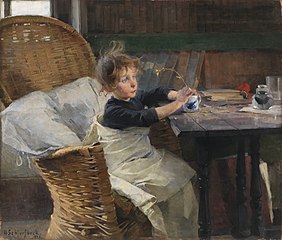 The Convalescent, Helene Schjerfbeck, 1888
The Convalescent, Helene Schjerfbeck, 1888-_The_Wounded_Angel_-_Haavoittunut_enkeli_(29568380521).jpg) The Wounded Angel, Hugo Simberg, 1903
The Wounded Angel, Hugo Simberg, 1903 Conveying a Child's Coffin, Albert Edelfelt, 1879
Conveying a Child's Coffin, Albert Edelfelt, 1879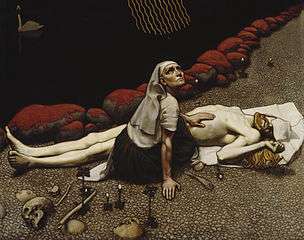
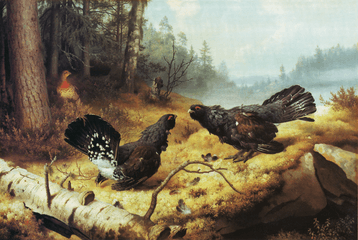 The Fighting Capercaillies, Ferdinand von Wright, 1886
The Fighting Capercaillies, Ferdinand von Wright, 1886- Road in Häme (A Hot Summer Day), Werner Holmberg, 1860
See also
- Culture of Finland
- Golden Age of Finnish Art
- Suomiart
- List of Finnish painters
- List of Finnish architects
- Category:Finnish sculptors by century
- Category:Finnish artists by century
References
- http://www.kansallismuseo.fi/en/nationalmuseum/exhibitions/permanent
- Hiekkanen, Markus (2011). "Suomen Taidehistoria" (PDF). Taidehistoria, Helsingin yliopisto (in Finnish). Helsinki University. Retrieved 2015-10-25.
- Heinänen, Seija. "Kuvataide Suomessa 1950- ja 1960-luvuilla". Ehtiihän Pariisiin (in Finnish). Art Museum in Jyväskylä. Retrieved 2015-10-25.
- "#FocusFinland: Your Crash Course on Finland's Contemporary Art Scene". Artsy. 2014. Retrieved 2015-10-25.
- Virolainen, Antti (8 May 2020). "Suomen taiteen kultakauden rakastetuimmat klassikot esillä Ateneumissa – tallenne suorasta lähetyksestä katsottavissa myöhemmin". Ilta-Sanomat. Retrieved 8 May 2020.
External links
| Wikimedia Commons has media related to Art in Finland. |
- The Golden Age of Finnish Art, Elina Ojala, University of Tampere.